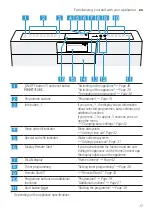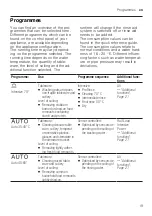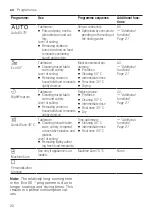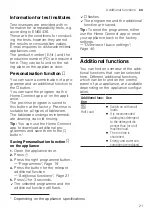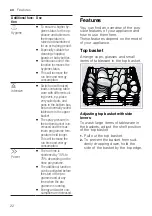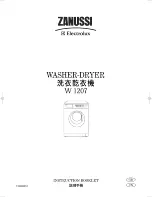
en
Environmental protection and saving energy
12
Zeolith drying
The appliance features a Zeolith con-
tainer. Zeolith drying lets you save
energy.
Zeolite is a mineral that can store
moisture and heat energy and then
release them again.
During dishwashing heat energy is
used to heat up the washing water
and dry the mineral.
During the drying phase moisture
from the interior of the dishwasher is
stored in the mineral and heat energy
is released. The heat energy is blown
out into the interior of the dishwasher
with dry air. This speeds up and im-
proves drying.
Zeolith drying therefore saves a great
deal of energy.
Tip:
To avoid impairing Zeolith drying
performance, do not position table-
ware parts directly in front of the in-
take opening or the blow opening of
the Zeolith container.
Do not position heat-sensitive table-
ware parts directly in front of the blow
opening of the Zeolith container.
→
AquaSensor
The AquaSensor is an optical meas-
uring device (light barrier) which
measures the turbidity of the rinsing
water. You can save water with the
AquaSensor.
Use of the AquaSensor depends on
the programme. If the soiling level is
high, the rinsing water is drained off
and replaced with fresh water. If the
soiling level is lower, the rinsing wa-
ter is used in the next wash cycle, so
reducing water consumption by 3-6
litres. In the automatic programmes
the temperature and run time are ad-
ditionally adjusted to the level of soil-
ing.
Sensors
The sensors adjust the programme
sequence and strength in the auto-
matic programmes depending on the
level and type of soiling.
The sensor has different sensitivity
settings that can be changed in the
basic settings.
→
Sensor setting
Description
Standard
Optimum setting for a
mixed load and heavily
soiled tableware. Saves
both energy and water.
Sensitive
Adjusts the programme
strength for effective re-
moval of food remnants
even with low soiling
levels. Energy and water
consumption are adjusted
accordingly.
Very sensitive
Adjusts the programme
strength for difficult condi-
tions of use, e.g. stubborn
dried-on food remnants.
Recommended setting
when using organic or eco-
logical detergents contain-
ing low levels of active
agents. Energy and water
consumption are adjusted
accordingly.

















